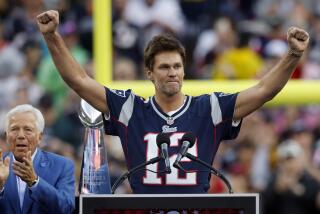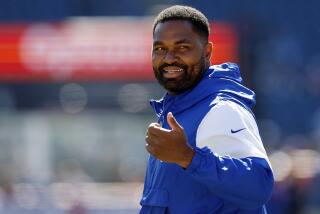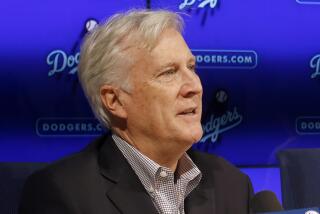HOLDING THE LINE : When NFL Management Calls Shots, the Old Guard Is an Effective Bloc
As they sift through their many problems these days, National Football League negotiators for both management and labor recognize two kinds of free agency.
There is the unconditional kind. Most Americans have that. They may live where they choose and if they are unhappy with their jobs, they are free to seek work elsewhere.
Then there is conditional free agency, which is sometimes awarded by sports leagues to older athletes, who can earn their freedom only by logging a specified number of years in the uniforms of the teams that signed or traded for them.
Both kinds of free-agent liberty are flatly opposed by the National Football League club owners responsible for managementâs position in the current dispute with the players.
They have been joined by most other owners in pro football, but not by all.
From their offices in Texas and Colorado this week, Lamar Hunt and Pat Bowlen, who own, respectively, the Kansas City Chiefs and the Denver Broncos, illustrated the range of NFL opinion on the subject.
Hunt, siding with managementâs negotiating committee, said: âFree agency wouldnât help the league in the long run.â
Bowlen, who is opposed to unrestricted free agency, said that if the conditional variety comes up for realistic consideration, âI would look at it. Iâm not as spooked on (freedom for veterans) as some people.â
It never surprises Hunt to find at least 28 views on anything in a 28-team league.
âWe have three (decision makers) on our club,â he said, meaning President Jack Steadman, General Manager Jim Schaaf and owner Hunt. âAnd even on (free agency), we donât all feel exactly the same way.â
The fact is that in their philosophic approach to football, some club owners are hard-liners, some are more moderate.
None of them will discuss it in detail, but there seems to be something of an NFL consensus on the following:
--The conspicuous hard-liners are the two most prominent members of the leagueâs Management Council, the group that supervises the battle against the union. They are Hugh Culverhouse, president of the Tampa Bay Buccaneers, and Tex Schramm, president of the Dallas Cowboys.
--The moderates--who generally are moderate on some but not all issues--are the Rooneys of Pittsburgh, the Sullivans of New England, Art Modell of Cleveland, Al Davis of the Raiders and most of the leagueâs newer owners: Bowlen in Denver, the Nordstroms of Seattle, the DeBartolos of San Francisco, Alex Spanos of San Diego and the so-called car dealers, Norman Braman of Philadelphia and Tom Benson of New Orleans.
âCar dealers are always deal makers,â the playersâ counsel, Dick Berthelsen, said, expressing a wish that the leagueâs negotiating team could be widened.
On free agency, though, at least in Modellâs opinion, it wouldnât help the union if the negotiating team were widened to all 28 franchises. âIf we voted today, it would be 28-0 against,â he said.
On other issues, the owner of the Cleveland Browns finds it difficult to divide the NFL into left and right.
âAs I have said many times, (NFL owners) are Republicans who vote socialistic,â Modell said. âThe 28 clubs split all (material resources) equally--TV money, assessments, even the gate. Itâs 60-40 for all at home, 40-60 on the road.â
If on some issues the NFL does occasionally divide into Republicans and Socialists, their feet are often planted in shifting sands.
Thus in Pittsburgh, for example, Steeler President Dan Rooney is remembered as the whiz who ended the last NFL strike five years ago. But he lives in a city where some people blame the collapse of the Pittsburgh Pirates on baseballâs free agency. So, this year, the Rooney family is fighting against free agency for the NFL.
Several questions remain.
In a league whose many overtime ownersâ meetings suggest that there are often disagreements, who, finally, sets NFL labor policy?
Who directs the leagueâs chief negotiator, Jack Donlan? How, exactly, does NFL policy work its way down to Donlan, the man who confronts the union at the bargaining table?
The outline of pro footballâs chain of command is visible through the smoke of battle. It extends down from the owners through the Management Council and the councilâs executive committee to Donlan.
THE OWNERS
NFL policy is set by the owners when they convene in executive session, as they do several times a year. Each team is limited to representation by one person with one vote--usually the owner or his most trusted subordinate.
On labor issues, club sources say, the NFLâs old guard has had the strongest voice for many years, taking the initiative to get what is always a hard-line policy approach to the players.
The younger owners support much of this policy but are often more willing to negotiate. Pro football is a strange industry because of the differences in franchise investment. Early owners got in for $500 or less. Others have paid $50 million or more.
Thus, a strike is less costly to an old-guard owner than it is to an individual with a recent large investment requiring, perhaps, large annual interest payments. Hence, new owners tend to be less willing than the old to accept a strike.
The NFL, however, is a minority-rules league. It takes 21 of the 28 votes to change league policies that have been established over the years. Even if younger owners favor more moderate policies, they canât outvote the old guard.
A difference of opinion on guaranteed contracts--rare in the NFL--illustrates the scope of the problem.
Modell, an NFL leader, sides with the old guard on the question.
âIn a vigorous contact sport like football, there wouldnât be an incentive or motive to keep playing if you had a guaranteed contract,â he said.
From Denver, however, Bowlen, one of the younger owners, said: âSure, it may take the incentive out of playing hard (for some players). But there are give-and-take areas. Vesting a veteran after three games could be a fair arrangement. (A guaranteed contract) isnât as onerous as free agency.â
Many other new owners reason similarly, but most of the old owners see it Modellâs way. And it is they who set NFL policy accordingly.
MANAGEMENT COUNCIL
This group, which formally structures the leagueâs labor policy, consists of one member from each of the 28 clubs.
On any given club, the Management Council representative can be the same person who votes in an NFL executive session--or it can be someone else delegated by the owner.
The council was created some years ago solely to distance the 28 owners from the commissioner, Pete Rozelle.
âItâs a different entity legally (from the NFL),â Hunt said from Kansas City. âPete isnât directly involved, although he sometimes attends council meetings.
âYou need a separation because Pete, as the commissioner, rules on things involving players. The sole purpose of the Management Council is to negotiate and deal with the (union). Itâs expensive, with a big staff and a big budget.â
During the councilâs deliberations, which arenât open to the public, representatives from old-guard teams continue to lead the way because momentum and experience are on their side.
In NFL seniority, their leader, Culverhouse, is a relatively new owner whose pro football affiliation dates only from 1975. But philosophically, Culverhouse aligns with the NFLâs right wing.
H.R. (Bum) Bright of the Cowboys is an even newer owner, but Bright is influenced by the clubâs president, Schramm, a veteran hard-liner.
COUNCIL EXECUTIVE COMMITTEE
Because the Management Council is an unwieldy group, it has created an executive committee--known as the CEC--as its supervisory agency.
The CEC functions as the NFLâs strike committee, and its role is better understood when it is called that.
âItâs difficult for one person (Donlan) to report to 28,â Hunt said. âThe executive committee is a six-person (board) chaired by Hugh Culverhouse.â
Other members are Joe Robbie of Miami, Michael Brown of Cincinnati , Charles Sullivan of New England, Dan Rooney and Schramm.
The NFLâs labor machine works as follows:
--It was at an ownersâ executive session that this yearâs most radical policy measure was adopted. The proposal: Continue the regular season with nonunion players.
According to club sources, the owners favoring this plan argued, first, that it would put pressure on union players to report. Second, they said, âthe strike is overâ if the pressure gets a nucleus of six or eight players from each team to cross picket lines.
The owners see the present conflict not as a fight over money, the sources said, but as an all-out fight against the players for power. Their objective, they say, isnât to break the union but to cripple it, or at least weaken it.
--The Management Council was charged with implementing the ownersâ policy by coordinating with coaches and general managers on the club level.
--The strike committee is the enforcement group.
JACK DONLAN
Donlan, the man who heads the Management Councilâs negotiating team, gets his instructions in strike committee meetings or from Culverhouse.
A trained negotiator with a background in airline labor disputes, Donlan is the councilâs executive director.
âAll we hear is Jack saying no,â a union source said.
But the results would be the same if Culverhouse were sitting there.
Donlan is the extension of Culverhouse, who is the extension of a majority of NFL owners.
A club source said: âJack does have some flexibility, and heâs judged by the way he gets agreements that are more what we want than what the players want.
âItâs like (Ram owner) Georgia Frontiere dealing with (running back) Eric Dickerson. She sets the upper and lower limits of what can be offered to each Ram player.
âItâs somebody else, though, (vice president John Shaw) who does the actual dickering with Dickerson and the other guys--and who gets a bonus from Georgia if he comes in on the low side of what heâs authorized to offer.â
Donlan has one clear advantage over Gene Upshaw, who negotiates for the NFL Players Assn. on behalf of the unionâs strike committee. Donlan has only 28 bosses, Upshaw 1,600.
Upshaw has to spend much of his time in the field meeting with the players to make sure that what heâs demanding from Donlan is still what they want.
Donlan only has to call Culverhouse, whose ear to the other owners is always perfectly tuned.
More to Read
Go beyond the scoreboard
Get the latest on L.A.'s teams in the daily Sports Report newsletter.
You may occasionally receive promotional content from the Los Angeles Times.










